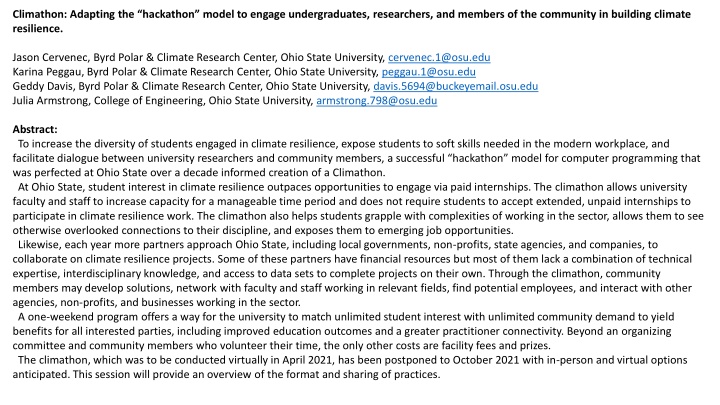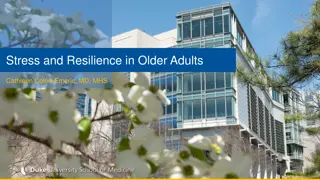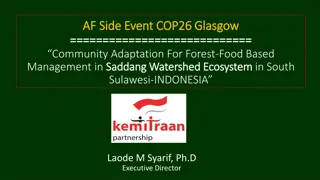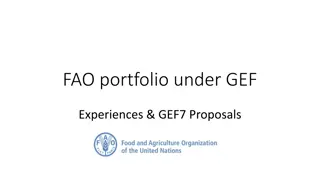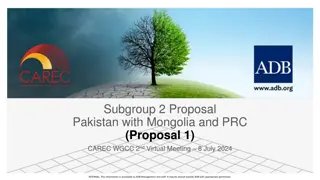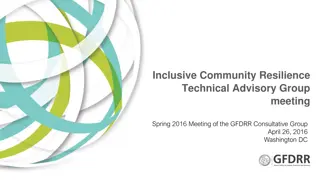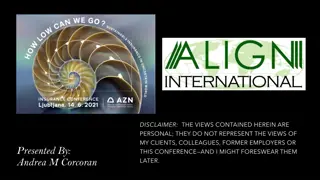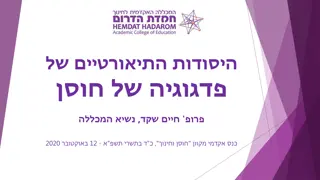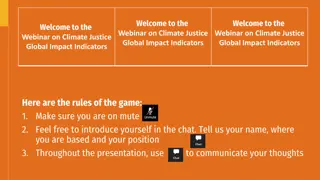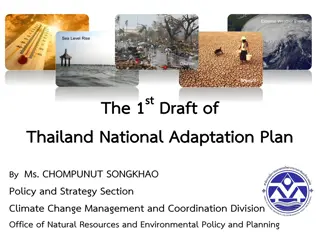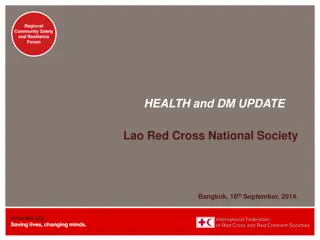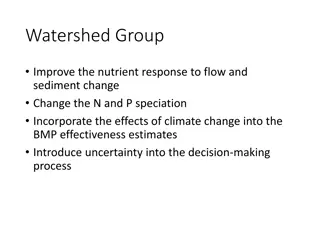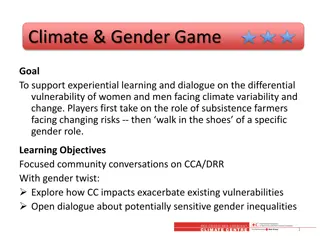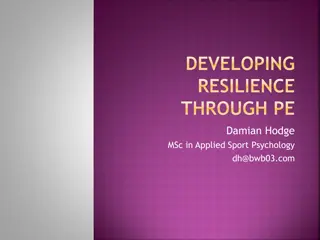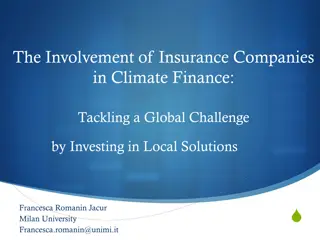Engaging Students and Community in Climate Resilience through Climathon
Adapting the hackathon model, Climathon at Ohio State University aims to broaden student engagement in climate resilience, provide real-world skills, and foster collaboration between researchers and community members. By offering a platform for interdisciplinary problem-solving and networking, Climathon addresses the growing interest in climate action across various fields, without requiring unpaid internships. This innovative approach connects students, faculty, businesses, and agencies to drive solutions for a sustainable future.
Uploaded on Nov 22, 2024 | 1 Views
Download Presentation

Please find below an Image/Link to download the presentation.
The content on the website is provided AS IS for your information and personal use only. It may not be sold, licensed, or shared on other websites without obtaining consent from the author.If you encounter any issues during the download, it is possible that the publisher has removed the file from their server.
You are allowed to download the files provided on this website for personal or commercial use, subject to the condition that they are used lawfully. All files are the property of their respective owners.
The content on the website is provided AS IS for your information and personal use only. It may not be sold, licensed, or shared on other websites without obtaining consent from the author.
E N D
Presentation Transcript
Climathon: Adapting the hackathon model to engage undergraduates, researchers, and members of the community in building climate resilience. Jason Cervenec, Byrd Polar & Climate Research Center, Ohio State University, cervenec.1@osu.edu Karina Peggau, Byrd Polar & Climate Research Center, Ohio State University, peggau.1@osu.edu Geddy Davis, Byrd Polar & Climate Research Center, Ohio State University, davis.5694@buckeyemail.osu.edu Julia Armstrong, College of Engineering, Ohio State University, armstrong.798@osu.edu Abstract: To increase the diversity of students engaged in climate resilience, expose students to soft skills needed in the modern workplace, and facilitate dialogue between university researchers and community members, a successful hackathon model for computer programming that was perfected at Ohio State over a decade informed creation of a Climathon. At Ohio State, student interest in climate resilience outpaces opportunities to engage via paid internships. The climathon allows university faculty and staff to increase capacity for a manageable time period and does not require students to accept extended, unpaid internships to participate in climate resilience work. The climathon also helps students grapple with complexities of working in the sector, allows them to see otherwise overlooked connections to their discipline, and exposes them to emerging job opportunities. Likewise, each year more partners approach Ohio State, including local governments, non-profits, state agencies, and companies, to collaborate on climate resilience projects. Some of these partners have financial resources but most of them lack a combination of technical expertise, interdisciplinary knowledge, and access to data sets to complete projects on their own. Through the climathon, community members may develop solutions, network with faculty and staff working in relevant fields, find potential employees, and interact with other agencies, non-profits, and businesses working in the sector. A one-weekend program offers a way for the university to match unlimited student interest with unlimited community demand to yield benefits for all interested parties, including improved education outcomes and a greater practitioner connectivity. Beyond an organizing committee and community members who volunteer their time, the only other costs are facility fees and prizes. The climathon, which was to be conducted virtually in April 2021, has been postponed to October 2021 with in-person and virtual options anticipated. This session will provide an overview of the format and sharing of practices.
Climathon: Adapting the hackathon model to engage undergraduates, researchers, and members of the community in building climate resilience. Geddy Davis davis.5694@buckeyemail.osu.edu Jason Cervenec cervenec.1@osu.edu Karina Peggau peggau.1@osu.edu Julia Armstrong armstrong.789@osu.edu Web: bpcrc.osu.edu Facebook: /byrdpolar Twitter: @byrdpolar
Students Desire to expand climate resilience work beyond students in geography, atmospheric sciences, Earth sciences, and engineering Significant requests from undergraduate students to learning about and responding to climate change Identified need to expose students to the complexity and multidisciplinary nature of climate resilience work seldom experienced in the classroom Way to showcase emerging career opportunities Avoid unpaid internships for students to gain experience Why did we do this? Faculty and Researchers Businesses, Agencies, and Non-Profits Opportunities for employers to find interns and job candidates Acknowledge the limited time available for faculty and researchers to take on more interns Growing demand for information and products for non-profits and agencies that either lack knowledge to take first steps or resources to pay for services Overall Networking event for faculty, researchers, community members, agencies, and employers to share current knowledge, identify needs, and explore collaborations Organizing team's interest in trying something fun and different Way to involve students, faculty, researchers, and community members, agencies, and employers in developing solutions rather than just learning Focus on actionable, local initiatives to avoid feelings of defeatism
Hackathon Overview Hackathon Overview Students select their own teammates Students select their own projects / problem statements Depending on the event goals, focus can be more on ideation and presentation less on implementation It is not about security Hack = to cobble together + athon = from 'marathon'
Hackathon Outcomes at OSU Hackathon Outcomes at OSU Growing a community! 100 students at HackOHI/O in 2013 to 800+ in 2019. Single hackathon turned into the OHI/O learning program including workshops, multidisciplinary events, short- and long-term competitions, alumni engagement, industry collaborations, etc. serving over 1,500 students across campus each year Hackathon event outcomes: Students meet new friends or strengthen working relationships with past teammates Tackle a problem of their own interest and practice presenting Judges provide feedback for student growth New ideas! Winners often go on to other competitions and notable achievements
Chronology Chronology Pro Tips: Consult partners, faculty, etc. to develop compelling challenges Reach out to potential mentors and judges, be honest about the experimental nature of the program Begin marketing, assign a point person for quick updates Communicate regularly with all parties involved
Inaugural Inaugural Challenges Challenges Atmospheric Sciences & Computer Programming Using historical data collected in the first few months of OSU s Campus Mesonet, create a series of visualizations and integrate into a "dashboard" that could be used to share accurate and meaningful information with professionals and the general public. Land Use, Ecosystems, and Social Impact Arts and Humanities Develop original artwork or media that educates and inspires residents of Central Ohio about climate resilience while also evoking reflection. Art and media forms include, but are not limited to: comedy, performance, dance, music, poetry, short stories, visual arts, graphic arts, and sculpture. Develop tools for residents of the city of Columbus to promote, incentivize, and support best practices for learning about, planting, and maintaining native, climate change tolerant trees and pollinator gardens on their property.
Requirements for an In Requirements for an In- -Person Event Person Event People Organizing committee Volunteer mentors and judges with backgrounds connected with the challenges (ideally, these are the same individuals who helped develop the challenges) Networks and connections to both recruit mentors/judges and market to student participants Physical Assests and Resources Facility that can accommodate participants and volunteers for the duration of the program (24 to 48 hours) Budget for merch/swag, prizes, food, beverages, and space rental (could include in-kind donations, corporate sponsorship, grants, etc.)
Infrastructure for a Virtual Format Infrastructure for a Virtual Format Discord = Platform of Choice Traditionally used by the gaming community Evolved to Discord only as program capabilities were revealed Allowed us to welcome and orient teams of students, offer mentorship and support, and judge final projects all in one place Separate channels allow teams places to ask questions, receive support, brainstorm, etc. with organizers and judges being given access to separate channels Original plan was to run entire program off Discord because it includes a VoIP, instant messaging and digital distribution platform designed for creating communities Divide sessions into days/times and support available through Discord (with phone/Zoom for tech support backup and Zoom Webinar for final showcase) Feedback from prior use at OSU suggested that judges would need training in advance and support throughout to use Discord successfully A look at our Discord server "home base", featuring both public and private channels...
POSTPONED & RETURNING WITH A HYBRID FORMAT AUTUMN 2021 Everyone agreed that Spring 2021 was too much to handle.
Lessons learned Lessons learned so far... so far...
To learn To learn more... more...
